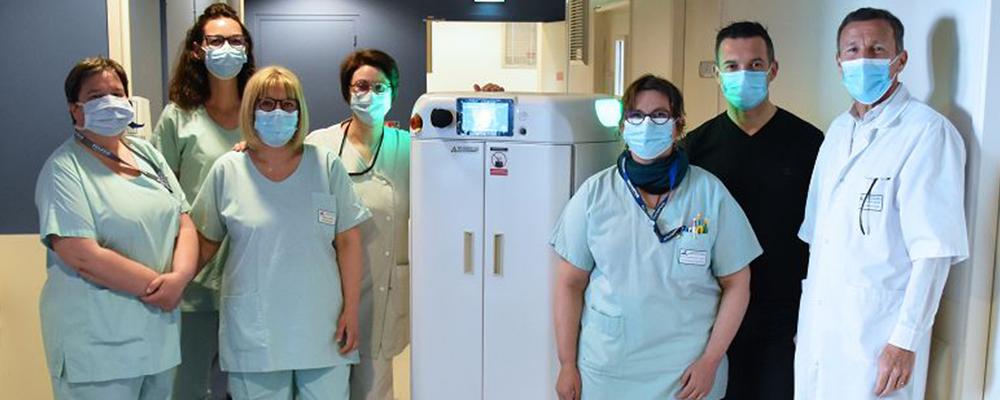
University Hospital Nantes case: Autonomous mobile robotics at the service of hospital logistics
- Expertise
- Temps de lecture : 10 min
The French Association for Logistics defines hospital logistics as follows: “The management of the flow of patients, products, materials, services and related information, to ensure quality and safety at a defined level of performance and efficiency, from the supplier to the patient and, as the case may be, to the final recipient”. Indeed, hospitals are increasingly surpassing the economic vision of logistics by moving towards the implementation of sustainable approaches that take into consideration the environment, ethics and quality of life at work.
Through this interview with Tony Perlemoine, Logistics Project Manager of the Nantes University Hospital, discover his feedback on the use of autonomous mobile robots at the University Hospital.
Mr. Perlemoine’s main mission is the flows of the new hospital which should see the light of day in 2026. To do this, he must face many challenges:
- Flow management between the logistics rear base and the future hospital, which will be 2 km away.
- Rethink the organization of the logistics platform to meet the challenges of the new hospital.
Indeed the project of the new hospital on the island of Nantes is based on a strong conviction : the new hospital must be designed to offer the best conditions of care to the patient and to improve the working conditions of the staff.
How long have you been using autonomous mobile robots?
T.P.: “It has already been seven years since we introduced autonomous mobile robots. We were the first hospital in France (along with the CH de Beauvais, which did not renew the experiment after the Vecna robots were stopped) to put this technology into service.”
Why did you decide to implement autonomous mobile robots in your hospital?
T.P.: “The Flexible Endoscope Disinfection Center (CETRES) was created to centralize the disinfection of endoscopes. Indeed, one of the challenges of centralization was to professionalize the management of endoscopes since the risk incurred is the microbiological contamination of the canals, which generally occurs when an endoscope has been used and the waiting between use and treatment by disinfectants is long.
The disadvantage of this centralization resulted from the fact that the CETRES was thus far from the care units. In order to overcome this problem, we first set up a courier system, with deliveries at fixed times, but we were limited due to its inflexibility. We then decided to optimize deliveries through a flexible and automated system with the installation of the first autonomous mobile robots of the university hospital center, the Vecna robots. At the time, it was very innovative for us and moreover even today because very few hospitals are still equipped with it. A few years later, we had to change the Vecna robots by Omron robots, put into service by the Assystem company and since April 1st we have just switched to our 3rd generation of autonomous mobile robots with the Meanwhile company. »
How does your next-gen app work?
T.P.: “CETRES, a flexible endoscope processing centre, prepares the endoscopes that will be needed for the operations. These endoscopes are placed in transport containers covered with green film, which are loaded into the secure cabinets of the two mobile robots. Once loaded, the robots are sent to deliver the endoscopes to the care units that have made the request. As soon as the robot has arrived at its delivery point, it calls the care unit concerned to notify of its presence. The alerted nursing staff unlocks the secure cabinet with the badge reader and retrieves their order. Once the delivery is complete, the robot automatically leaves for another run, taking the elevator in complete autonomy to access the various care units. »
Are robots accepted?
TP: “Yes. What really makes the success of this project is the investment of CETRES staff in the use of robots. At the time we were a “test laboratory” and today CETRES staff are rewarded with more reliable robots. The CETRES agents saw rapid interest and the team was immediately won over by the application of these robots.
For the care units, the only constraint was not to degrade the quality of the service provided by the couriers. Mobile robots were therefore very quickly accepted because of their ease of use. A use that continues to be facilitated with the implementation of new latest generation robots.
Finally, the people who had the most reluctance to accept this technology were certain agents who thought that the robots were going to interfere with their daily lives. In the end, this concern dissipated fairly quickly, because we implemented a certain number of parameters to facilitate interactions with the robots (work on the trajectories and the position of the robots in the corridors, triggering of music or speech to prevent their presence in cramped places, spot which diffuses a light on the ground…). They have become accustomed to rubbing shoulders with them and meeting them in the corridors with ease. »
What advice could you give to facilitate their acceptance?
T.P.: “It is very important to involve all the people who will work with the robot and above all to communicate well in order to facilitate their acceptance. »
What are the benefits of this app?
Their availability: “the robots are available at all times and this allows CETRES agents to smooth their activity. Thanks to robots, CETRES agents have gone from 4 deliveries a day to 40.”
Their reliability: “We know that the average delivery time is 10 min. »
Their communication:
- Facilitated communication between robots and care units: Indeed, when the robot has arrived at its delivery point, the staff does not see it. It therefore sends a call to the service concerned via the DECT. (Digital Enhanced Cordless Telecommunications)
- Facilitated communication between robots and CETRES agents: when the robot is blocked, it will send an e-mail. Moreover, thanks to its camera and its map, we are able to follow the robot in real time.
Autonomy:
- Use of elevator
- The ability to avoid obstacles (fixed or mobile)
- To resume his journey if he has been arrested and moved during one of his missions
No modification of the existing infrastructure. “Only a wifi coverage is necessary”
Do you have other application needs?
T.P.: “The objective was to test these new robots for the new Ile de Nantes hospital, which ended in a winning trial; indeed 7 years later the mobile robots are still there. We are considering very seriously that these robots are transferred to the new hospital and as proof, in the future CETRES, the recharging points for the robots are already planned.
We also plan to deploy these robots for other applications, such as the transport of analysis tubes within the laboratory and for the transport of chemotherapy between the pharmacotechnics center and the various care units. »
What do you see as the future of autonomous mobile robotics in healthcare facilities?
T.P.: “I am convinced that tomorrow the AMRs in hospitals will be deployed. The various contacts that I can have with my colleagues from different hospitals show the growing interest in this technology. »
Some statistics concerning the use of the two autonomous mobile robots, XuP-Med, at the Nantes University Hospital:





100 km per month
80 daily elevator rides
2200 endoscopes per month
40 assignments per day
1760 round trips per month